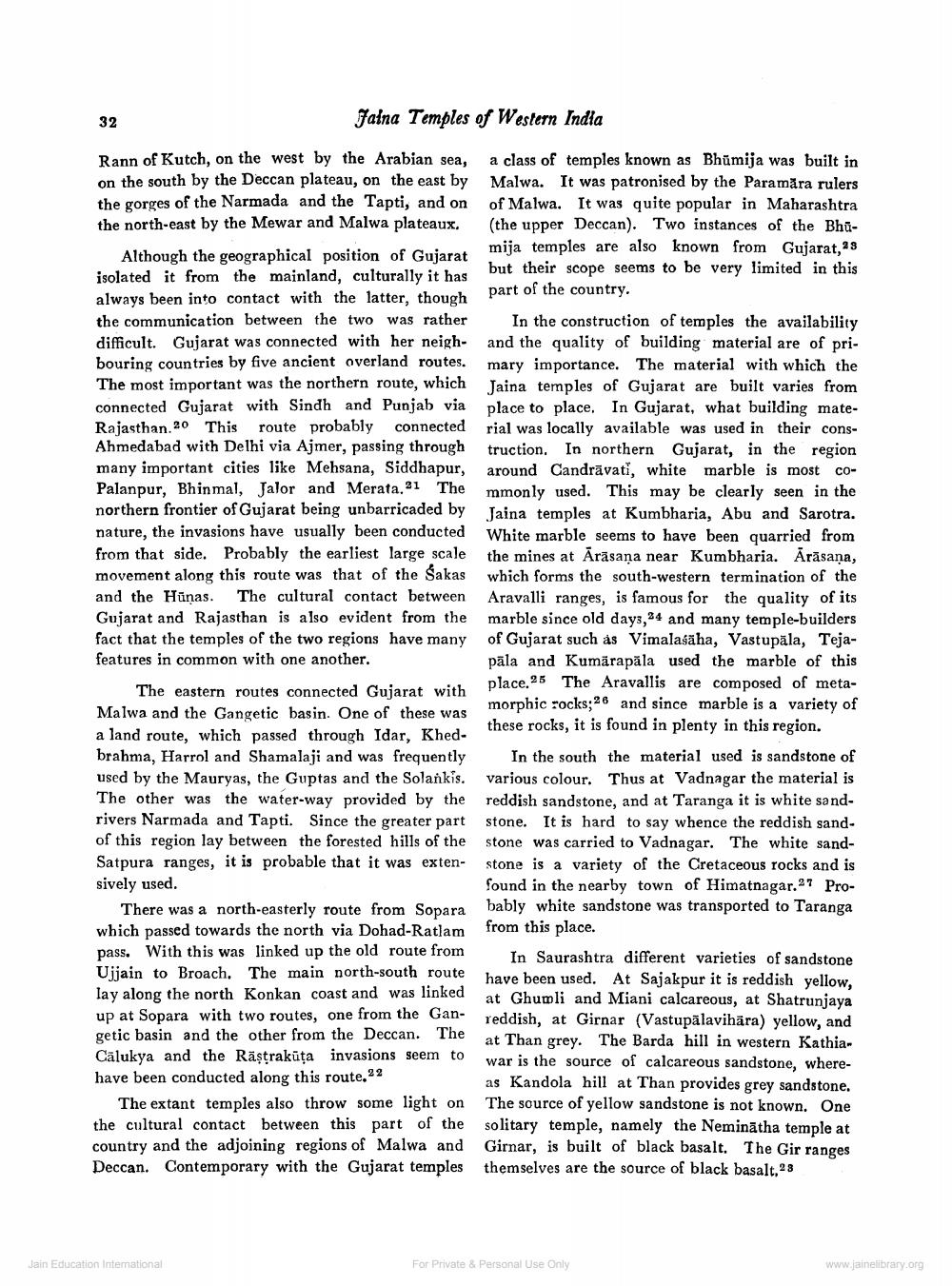________________
32
Falna Temples of Western India
Rann of Kutch, on the west by the Arabian sea, a class of temples known as Bhūmija was built in on the south by the Deccan plateau, on the east by Malwa. It was patronised by the Paramāra rulers the gorges of the Narmada and the Tapti, and on of Malwa. It was quite popular in Maharashtra the north-east by the Mewar and Malwa plateaux. (the upper Deccan). Two instances of the Bhū
mija temples are also known from Gujarat, a 3 Although the geographical position of Gujarat
* the mainland, culturally it has isolated it from
but their scope seems to be very limited in this always been into contact with the latter, though the communication between the two was rather In the construction of temples the availability difficult. Gujarat was connected with her neigh- and the quality of building material are of pribouring countries by five ancient overland routes. mary importance. The material with which the The most important was the northern route, which Taina temples of Gujarat are built varies from connected Gujarat with Sindh and Punjab via place to place. In Gujarat, what building mateRajasthan 20 This route probably connected rial was locally available was used in their consAhmedabad with Delhi via Ajmer, passing through truction. In northern Gujarat, in the region many important cities like Mehsana, Siddhapur, around Candrāvati, white marble is most COPalanpur, Bhinmal, Jalor and Merata.21 The mmonly used. This may be clearly seen in the northern frontier of Gujarat being unbarricaded by Jaina temples at Kumbharia, Abu and Sarotra. nature, the invasions have usually been conducted White marble seems to have been quarried from from that side. Probably the earliest large scale the mines at Āräsana near Kumbharia. Arāsana, movement along this route was that of the Sakas which forms the south-western termination of the and the Hūnas. The cultural contact between Aravalli ranges, is famous for the quality of its Gujarat and Rajasthan is also evident from the marble since old days, 24 and many temple-builders fact that the temples of the two regions have many of Gujarat such as Vimalasäha, Vastupāla, Tejafeatures in common with one another.
pala and Kumārapāla used the marble of this
place.25 The Aravallis are composed of metaThe eastern routes connected Gujarat with
morphic rocks; 26 and since marble is a variety of Malwa and the Gangetic basin. One of these was
these rocks, it is found in plenty in this region. a land route, which passed through Idar, Khedbrahma, Harrol and Shamalaji and was frequently In the south the material used is sandstone of used by the Mauryas, the Guptas and the Solankis. various colour. Thus at Vadnagar the material is The other was the water-way provided by the reddish sandstone, and at Taranga it is white sandrivers Narmada and Tapti. Since the greater part stone. It is hard to say whence the reddish sandof this region lay between the forested hills of the stone was carried to Vadnagar. The white sandSatpura ranges, it is probable that it was exten- stone is a variety of the Cretaceous rocks and is sively used.
found in the nearby town of Himatnagar.27 ProThere was a north-easterly route from Sopara bably white sandstone was transported to Taranga which passed towards the north via Dohad-Ratlam from this place. pass. With this was linked up the old route from In Saurashtra different varieties of sandstone Ujjain to Broach. The main north-south route have been used. At Sajakpur it is reddish yellow, lay along the north Konkan coast and was linked
at Ghumli and Miani calcareous, at Shatrunjaya up at Sopara with two routes, one from the Gan
reddish, at Girnar (Vastupālavihära) yellow, and getic basin and the other from the Deccan. The
at Than grey. The Barda hill in western KathiaCalukya and the Rästraküța invasions seem to war is the source of calcareous sandstone, wherehave been conducted along this route 22
as Kandola hill at Than provides grey sandstone. The extant temples also throw some light on the source of yellow sandstone is not known. One the cultural contact between this part of the solitary temple, namely the Neminātha temple at country and the adjoining regions of Malwa and Girnar, is built of black basalt. The Gir ranges Deccan. Contemporary with the Gujarat temples themselves are the source of black basalt.23
Jain Education International
For Private & Personal Use Only
www.jainelibrary.org




